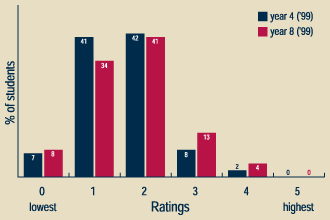|
Questions / instructions:
On each student's table
place a sheet of grey sugar paper on a cardboard under–surface, and a set
of 12 pastels and 12 crayons arranged tonally on a tray.
Show video tape.
Cave Creature video
script.
In this
activity you are going to draw a picture of a make-believe cave creature. You
will have your own set of crayons and pastels to work with. Try to use both the
crayons and pastels in ways that make your colours and shapes look strong, bright
and really effective. You can get different effects in your colours and shapes
by using crayons and pastels over the top of each other. You can blend, mix and
rub different colours in all sorts of interesting and unusual ways. Now let's
think about that make-believe cave creature – your very own special cave
creature that comes from your own ideas and imagination. A cave creature that
glows big, bright and colourful. Imagine that at night your creature lives in
a huge hollow cave at the edge of a steamy, swampy pool of weedy water. During
the daytime it likes to stomp and stalk through the bushes and grasslands, and
to cool off in a pool of slimy mud, muck and water that surrounds its cave. Let's
pay attention to the creature you are going to draw. It's a strange kind of creature,
because in one way it helps to protect the swampy pool and everything that lives
in it, but in another way it can be scary and frighteningly fierce. As well as
being a good protector, it can also be an awesomely powerful beast that none other
would like to tackle or challenge. Think about what your cave creature might look
like. Think about the size and shape of its body, and think about the parts of
its body – its eyes, its nose, its mouth, its teeth, its tongue and its powerful
jaws. This cave creature is going to look strong, fierce, alert and full of energy?
It's a creature that can bellow an enormous and spine–shivering roar that
will make attackers twitch and tremble? Think about its spine, its tail, its legs
and claws. This creature can stomp and splash and thrash its way through the mucky
pool as well as run, prance, grab and shake with great power and speed? By now
you will be thinking hard about the shape, colours, body parts and body patterns
of your wonderful cave creature – a cave creature that will seem to have
almost magical powers to protect and attack. No one has ever seen a real live
cave creature of this kind, so no one can ever say that your drawing is right
or wrong. But try to make it special, interesting, and as big as you can make
it, so that it fills your paper.
You need to work quite quickly
to do as much as you can in 20 minutes.
Remember — bright,
glowing colours and a wonderfully big and powerful cave creature.
When there is 5 minutes
to go, remind students of the time remaining.
|
